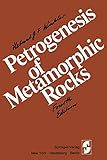Petrogenesis of metamorphic rocks Libro electrónico autor: Helmut G. F. Winkler
Tipo de material: Libro
en línea Idioma: Inglés Detalles de publicación: New York, New York, United State Springer-Verlag c1976Edición: Cuarta ediciónDescripción: x, 334 páginas ilustraciones 23 centímetrosISBN:
Libro
en línea Idioma: Inglés Detalles de publicación: New York, New York, United State Springer-Verlag c1976Edición: Cuarta ediciónDescripción: x, 334 páginas ilustraciones 23 centímetrosISBN: - 0387074732
- 9783540780137 (Print)
- 9783662222836 (Online)
- Disponible en línea
Incluye bibliografía e índice: páginas 331-334
1. Definition and types of metamorphism.. 2. From diagenesis to metamorphism.. 3. Factors of metamorphism.. 4. Mineral parageneses: the building blocks of metamorphic rocks.. 5. Graphical representation of metamorphic mineral parageneses.. 6. Classification principles: metamorphic facies versus metamorphic grade.. 7. The four divisions of metamorphic grade.. 8. General characteristics of metamorphic terrains.. 9. Metamorphic reactions in carbonate rocks.. 10. Metamorphism of marls.. 11. Metamorphism of ultramafic rocks: systems MgO-SiO2-CO2-H2O and MgO-CaO-SiO2-H2O.. 12. Metamorphism of mafic rocks.. 13. Very-low-grade metamorphism of graywackes.. 14. Metamorphism of pelites.. 15. A key to determine metamorphic grades and major isoreaction-grads or isograds in common rocks.. 16. Regional hypersthene zone (granolite high grade.. 17. Eclogites.. 18. Anatexis, formation of migmatites, and origin of granitic magmas.. Index
Disponible para usuarios de ECOSUR con su clave de acceso
The first edition of this book was published in 1965 and its French translation in 1966. The revised second edition followed in 1967 and its Russian translation became available in 1969. Since then, many new petrographic observations and experimental data elucidat- ing reactions in metamorphic rocks have made a new approach in the study of metamorphic transformation desirable and possible. It is felt that this new approach, attempted in this book, leads to a better unders- tanding of rock metamorphism. The concept of metamorphic facies and subfacies considers asso- ciations of mineral assemblages from diverse bulk compositions as characteristic of a certain pressure-temperature range. As new petrographic observations accumulated, it became increasingly difficult to accommodate this information within a manageable framework of metamorphic facies and subfacies. Instead, it turned out that mineral assemblages due to reactions in common rocks of a particular composi- tion provide suitable indicators of metamorphic conditions. Metamorphic zones, defined on the basis of mineral reactions, very effectively display the evolution of metamorphic rocks. Thus the im- portance ofreactions in metamorphic rocks is emphasized. Experimen- tal calibration of mineral reactions makes it possible to distinguish reac- tions which are of petrogenetic significance from those which are not. This distinction provides guidance in petrographic investigations un- dertaken with the object of deducing the physical conditions of metamorphism. Inglés
Disponible en línea
Disponible en formato PDF


